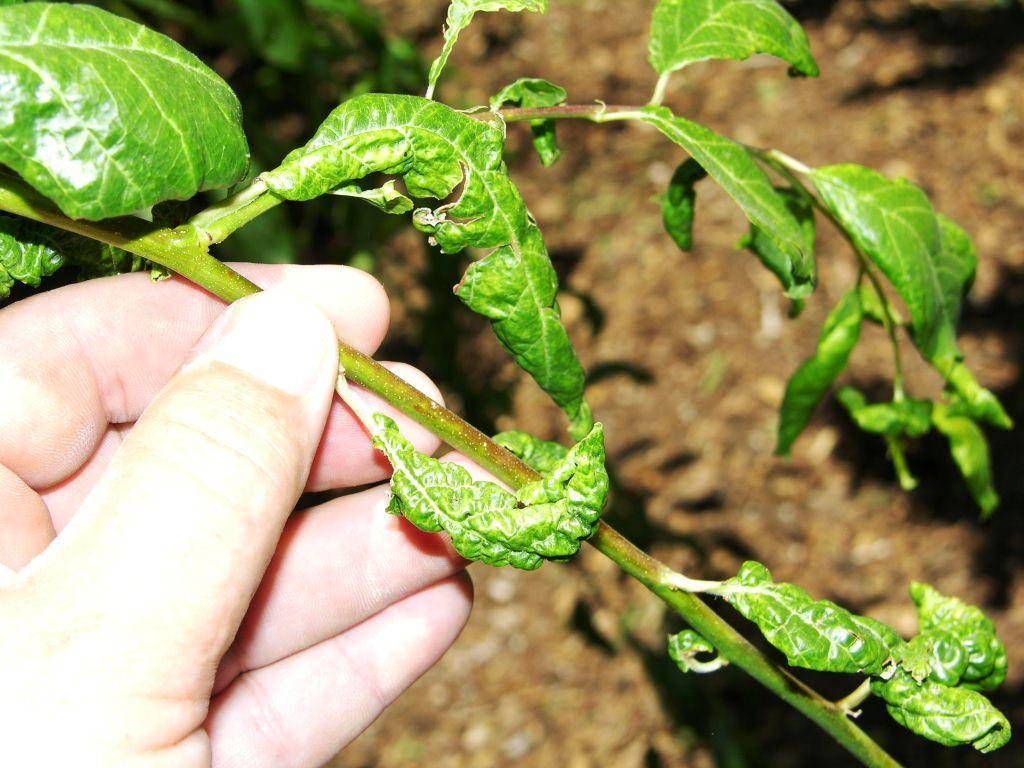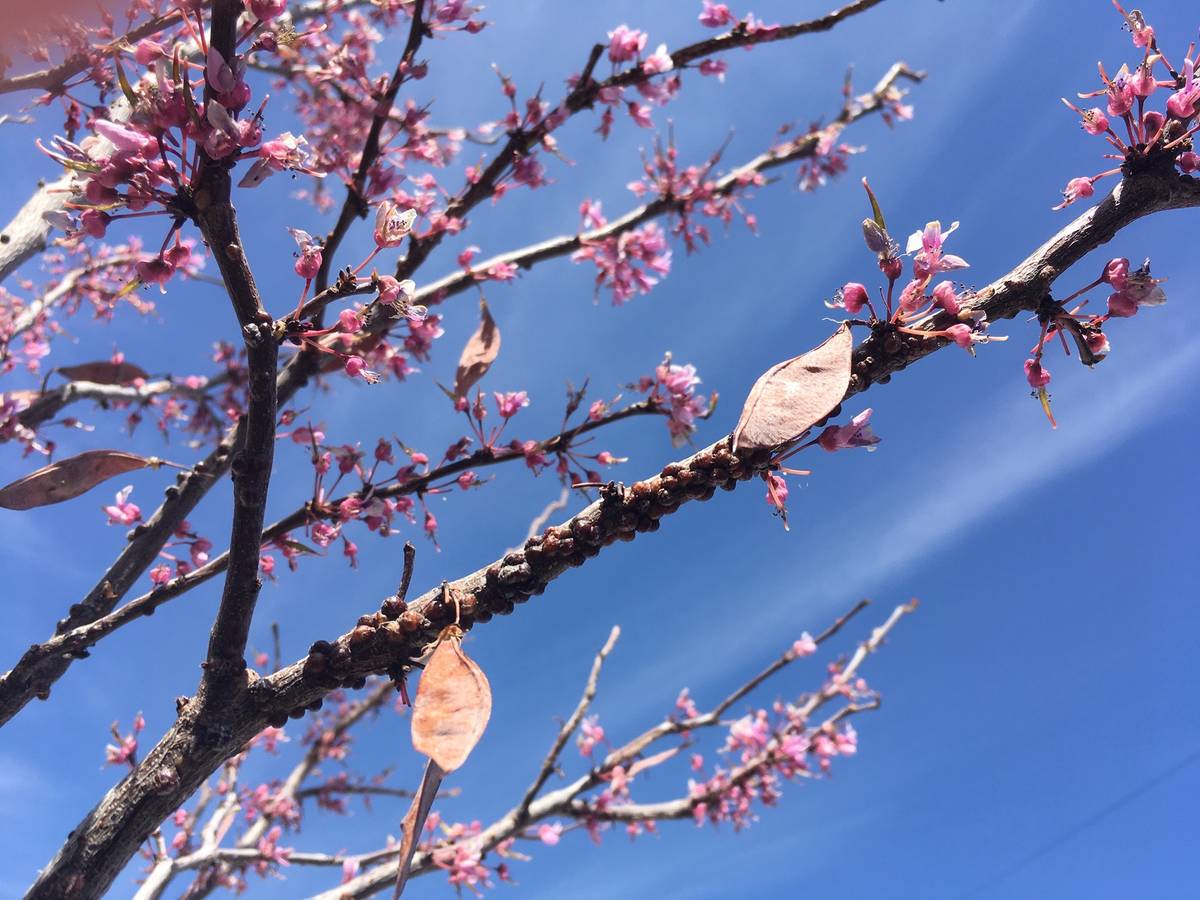Aphids are problematic on new growth this time of year
Q: The new growth at the ends of my roses came out small and curled. Now the same thing is happening to my Meyer lemon tree.
A: This time of year, when it’s cool, are when aphids are a big problem on new growth. Curling leaves is a spring indicator that aphids are present.
Open these curled leaves, and you will see aphids inside feeding. Later leaves growing below this infested area become shiny and sticky as the problem worsens. This shiny and sticky deposit on the leaves is a sugary mess deposited by aphids feeding on leaves above it.
It might still be a little early, but when ants wake up from their winter sleep in their subterranean nest, they will go after this sugary mess in a big way. These ants will signal to the rest of the colony that this sugar supply is available, and you will see long lines of ants working together to harvest this energy supply and take it back underground.
Following the line back to the opening of the nest will indicate where to apply ant bait to control them.
Aphid problems are one of the reasons I tell people to put a preventive oil spray on plants during the winter months. Aphids hide when it’s cold and wait for spring’s new growth so they can lay more eggs, feed and rear their young.
Spring is when the aphid cycle begins again. Winter is the time for prevention.
The feeding of aphids on growing leaves causes these leaves to curl and protect the adults and their young. When leaves are done growing, then this feeding doesn’t cause the leaves to curl anymore, but they turn yellow from feeding, produce a sugary mess and fall off. This leaf curling makes it difficult to spray anything that is not systemic and control aphids.
So this is the problem you have. Roses are not a problem because you can apply a systemic insecticide and control the aphids inside these curled leaves. Soap and water sprays will work but won’t get inside these crunched up leaves where aphids are propagating.
On food plants, like citrus, you are better off removing this infested growth and protecting any new growth from getting infested by aphids. Apply soap and water sprays when you see aphids starting to congregate on the undersides of leaves, but you must be diligent and inspect your plants regularly.
What to do? Prune off the curled leaves from food plants and protect new growth with soap and water sprays or neem oil and apply systemic insecticides only to the nonedible plants.
Q: I have run out of excuses for not starting my own compost but read conflicting opinions on where to place my compost bin. I could put it anywhere. Some say to put it in the sun while others like you say not too.
A: You will get different ideas where to place a compost bin depending on the part of the country where composting is done. If composting is done in upstate New York, the expert might tell you to compost in full sun where the compost pile can warm up during the winter.
In our hot and dry desert climate, it’s easier to compost in the shade. Composting doesn’t need warmth from the sun or even wind for that matter. Our desert has too much of both anyway.
Think of composting as controlled rotting. Then ask yourself, does rotting happen faster in the dark or in the sun? Anything you do to speed up rotting will speed up composting.
Composting is like growing mushrooms; neither light nor wind is necessary and, in fact, can slow it down or stop it. Like rotting, the ideal location is warm and moist with lots of available air.
Composting can be done hot or cold. Hot composting, where the compost pile produces its own heat, is the fastest and most effective way to compost. Compost will become hot if the ingredients, the compost pile and its environment are just right. That takes a little bit of knowledge and experimentation on your part to get everything just right.
Composting doesn’t need bins. The most effective way to compost is a hole in the ground, placed in the shade, where water applied to the compost can drain and whatever is rotting is in contact with the soil. Loosely cover this compost pit with a tarp to keep light and air out of it. You provided the perfect environment for rotting. Sorry, composting.
Composting is faster if the ingredients are freshly cut and as small as possible. Eggshells are very slow to rot but not if you blend them first.
Q: I have a redbud tree, and I think it has scale. Please tell me if it is scale, if this problem will damage the tree and what can I do to fix it. So far I have simply squished as many as I can by hand. It seems to work OK, but I think they are coming back.
A: Looking at the pictures you sent to me, your tree has scale insects all over its branches. This scale insect makes a ⅛- or ¼-inch bumps along the stem. Your tree is loaded with them.
Scale insects get their name because of the outer “scale” erected around their soft bodies when they set up home. This outer scale protects this insect from being eaten and any harsh environment.
There is an insect underneath that scale, and it sucks plant juices from the stems of the tree. It probably will not kill the tree, but it does weaken it. It is possible this scale could spread to other trees nearby, particularly fruit trees, and cause the same kind of damage.
Scale insects are either classified as hard or soft. Because you squished these scales with your fingers, that tells me it’s probably a soft scale. That’s one way to kill them, but you have hundreds on that tree if not thousands, and squishing all of them sounds like a daunting task.
The insect under the scale, called a “crawler,” is soft-bodied and easy to kill with just about any insecticide including smothering it with petroleum oils. Crawlers are the scale insects’ most susceptible stage and when they are easiest to kill. Depending on the scale, they could start spreading in the spring months as temperatures warm up.
As soon as spring arrives and the tree has finished flowering, spray along new leaves and stems with a horticultural oil. Horticultural oils will smother crawlers and keep them from spreading onto this new growth.
You can spray horticultural oils until temperatures get to about 85 degrees or consult the label. Repeat the horticultural oil spray in about one month.
Q: I divided my yucca back in November. It has done OK but not great. A few of my yucca’s young “pups” are growing. Also, the mother plant now has a bunch of stalks and blooms. Any suggestions?
A: If my memory is right, the yucca you have is called Spanish bayonet or Adams needle. It is a yucca native to the southeastern United States and will not like the strong sunlight and heat of our desert Southwest.
Hopefully, you will grow it perhaps in the east or north microclimates out of the intense heat. This yucca will sunburn in intensely hot locations.
Also, this yucca will grow best in soils amended with some compost and covered with wood chips. It will not like rock-covered soils past the first couple of years.
Yucca produces a flower stalk from the center of each plant in the spring. Unlike some agave, they usually don’t die after they flower. Joshua trees, for instance, are a Southwestern yucca. When you don’t like what’s left on the flower stalk anymore, remove it by cutting it as low on the stalk as possible and hiding the cut.
This past November was not the best time for young plants. We had some low temperatures, and it froze a couple of times in parts of the valley. Then the cold weeks of December and January started soon afterward.
Usually fall is a good time of the year for planting. Last year it wasn’t that great. This spring they will grow better if they were given a chance to heal after separating them from the mother plant and they were planted with some TLC.
Bob Morris is a horticulture expert and professor emeritus of the University of Nevada, Las Vegas. Visit his blog at xtremehorticulture.blogspot.com. Send questions to Extremehort@aol.com.






























